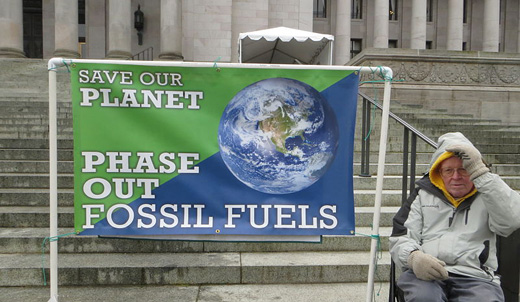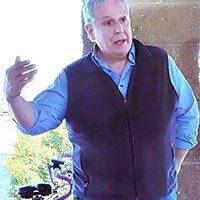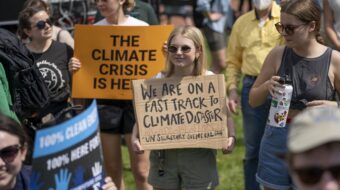
Climate change is in the news – good, bad and really good. First big item: The Intergovernmental Panel on Climate Change (IPCC) recently released the summary and first part of its latest every-seven-years report on climate change and the most recent scientific knowledge and consensus. Second: 350.org continues its battle against the Keystone XL pipeline, among many popular struggles that are growing.
The good news (relatively speaking, anyway): The IPCC report offers further confirmation of what we already knew, that climate change is real, escalating, and mainly caused by human greenhouse gas emissions. Why is this is good? Because more scientists, more scientific facts based on deeper research, and public coverage of climate change are all moving humanity closer to the significant actions that need to be taken to avert the worst impacts. It is another brick in the wall of public scientific understanding against climate denialism, against the cynical and manipulative efforts of the fossil fuel industry and ultra-right political hacks to avoid or at least delay action.
The other good news from the report: Human actions can still make a huge difference in how much warming the world experiences over the next 100 years. Way too much climate change is already “baked” into the system due to the carbon dioxide emissions already in the atmosphere, but we can make it worse or we can reverse course and keep it from getting truly apocalyptic. What humanity does over the next 10 or 20 years matters, as the range of predictions in the various IPCC models shows: It can be bad (it is already guaranteed to be) or it can be terrible – that is our choice. We can make a difference.
The bad news: The IPCC report doesn’t address all the issues that may make climate change worse. They have good scientific reasons – there is still uncertainty about many aspects of the interactions between the climate and other natural and human systems. And it is hard to put numbers into computer models when we don’t yet have accurate numbers. But it does mean that the IPCC predictions underestimate the danger of climate catastrophe.
For example, one potential tipping point is that the northern hemisphere is warming faster than the rest of the planet, which leads to melting of the permafrost. The permafrost contains many millions of tons of frozen greenhouse gases, and as it melts, those gases are released into the atmosphere. This has already created a feedback loop, in which global warming melts permafrost, releasing more greenhouse gases, making global warming worse, melting more permafrost, and so on. However, no one yet knows how fast this will happen, exactly how much greenhouse gas will be released and when, and how big an impact this will have on the global climate. This uncertainty makes it impossible to include this very real danger in the IPCC models. That doesn’t make the danger disappear, however. So as dire as the IPCC predictions are, they are incomplete.
Another example: As glaciers and ice sheets melt, they eventually release large amounts of fresh water that end up in the ocean. In one way this is a good thing, in the sense that it dilutes the increasing acidity of the ocean, already affecting fish, shellfish, and coral reefs. However, this amount of fresh water has the potential to cause shifts in the massive currents that drive the circulation of the ocean. And much of the weather of northern Europe depends on those ocean currents, which affect not just the long-term climate, but also the year-to-year weather patterns that enable northern Europe to maintain robust agricultural production. How much fresh water will be melted into the oceans? When? How much can be released before there is any significant impact on ocean currents? We don’t yet know the answers to these questions, and the IPCC certainly can’t report on any scientific consensus, but that doesn’t make the potential problem vanish.
That’s some of the bad news – it is going to be bad, and it may get even worse than we know, due to factors we do not yet understand enough to accurately measure or predict. Since the world is massive, the world’s climate system is massive, and it interacts with all other systems, natural and man-made: ocean acidity, soil fertility, the weather, rainfall, drought, forest fires, pollution, and how hospitable the world is to human life flourishing (or not). It intersects and interacts with humans’ systems of production, distribution, transportation, agriculture, habitation, construction, and more – all human life is a subset of the larger world ecology, and depends on that larger system for the resources and conditions necessary for human life to function.
The really good news: As climate change is escalating, the fightback is escalating as well.
- 350.org is leading two crucial current struggles, the effort to stop the Keystone XL pipeline, and the growing movement of campuses and in cities and states to divest from fossil fuel companies. In one recent innovative effort, activists built a solar-powered barn in Nebraska right in the path of the Keystone pipeline.
- Communities in the Pacific Northwest and anti-coal activists are campaigning against efforts to massively increase railroad traffic and port capacity to ship more dirty coal to China. A totem pole titled “We draw the line” is traveling the country as part of the campaign, carved by members of the Lummi Nation and supported by other Native American tribes and nations. Communities all along the path of the increased rail traffic are mounting local protests, petition drives, and public education efforts. Environmental activists are pointing out, as the “Do the Math’ video demonstrates, that much of the remaining fossil fuel needs to stay in the ground for the future of humanity.
- The scientific community is fighting back. Tired of being a punching bag for right-wing loonies (Ted Cruz’s “wacko bird” caucus), scientists are fighting back with facts, more in-depth studies, more publicity for scientific facts, and are engaging in the public discourse. Many scientists have realized that it is not enough to just have the facts on your side, you also have to join the public battles over what to do with those facts. James Hansen, for example, has gone from just testifying before Congress to getting arrested at a demonstration earlier this year, and regularly writes op-eds for major newspapers and magazines, as does scientist Michael Mann.
- Unions, at least some of them, are recognizing their interest in these battles, and joining environmental organizations as partners. This has been building for several years, with the Blue-Green Alliance, between the Steelworkers and the Sierra Club, campaigning for jobs building a new energy economy. The Connecticut AFL-CIO recently adopted a resolution on climate change.
- Environmental organizations, at least some of them, are realizing that they need an alliance with unions and workers in order to win. An appeal to the recent AFL-CIO convention by dozens of environmental groups called on the labor movement to take a leading role in the struggle, in the long-term interests of its members. In a recent speech to a Canadian union convention, Naomi Klein argued for unions to join the environmental battles.
- Many industries and small businesses are confronting the reality of climate change and its impact on their work.
For example, in the Pacific Northwest, oyster farmers have had to open seeding beds in Hawaii, since the traditional beds in Southwest Washington are experiencing too much ocean acidity for the oysters to begin forming shells. Once the oysters have successfully begun the process of shell growth, they are brought to the Northwest. But the traditional practices are no longer working. This brings home to many people in many areas that climate change science is real and we need to act.
Similarly, wine growers are realizing that in the future, the areas of the world that are best for growing wine grapes are going to be moving, and the entire industry needs to adapt, and to recognize that this shift has impacts far beyond just moving vineyards.
Increasingly, it is only the coal and oil industries that refuse to acknowledge the reality of climate change.
- As extreme weather events escalate around the country, from Hurricane Sandy to torrential rains and floods in Colorado, the hypocrisy of Republican anti-science anti-government elected officials is exposed. They are the “Only in My Backyard” caucus, voting against emergency assistance to anyone, except when it is in their own districts and might affect their chances of re-election.
- Fracking is also seeing many battles, as the leaks from processing shale oil pollute the drinking water of local communities, as the harmful chemicals used in the process spread to surrounding areas, and as the claims of safety by the industry are exposed as fraudulent.
- Many cities and states are receiving the results of studies of how climate change will impact them, and as a result there are battles at every level against Republican deniers – as in Norfolk, Va., and other coastal cities.
- With a recent legislative deal in Congress, several Obama appointees who had been unable to get congressional confirmation managed to get around the Republican roadblocks, including Gina McCarthy as director of the Environmental Protection Agency. She has moved aggressively to institute carbon emission limits for new power plants and begin the process for existing power plants. While this is of course not enough by itself, it is a major positive step forward, a down payment on President Obama’s commitment in his inaugural and State of the Union speeches earlier this year, where he promised executive branch action on climate change, saying “We don’t need a meeting of the Flat Earth Society.”
All these signs of a growing fightback are encouraging. We do have reason to know that what we do can make a difference, that we are not all doomed to a hot hell on earth.
Building struggles, forming coalitions, engaging in public education, winning workers to understand their self-interest in climate change battles, supporting legislators who are ready to take action, exposing right-wing and fossil fuel industry lies are all worthwhile efforts.
People no matter where they are can find ways to link up with one or another of these struggles, movements, and organizations. And that’s a good reason for our hope for the future of humanity to grow and flourish.
Photo: Ted Nation, longtime activist, sits beside a sign during a protest against coal trains shipping dirty coal to China, at the Legislative Building in Olympia, Wash., Jan. 14, 2013. Brylie Oxley/Wikipedia Commons.












Comments